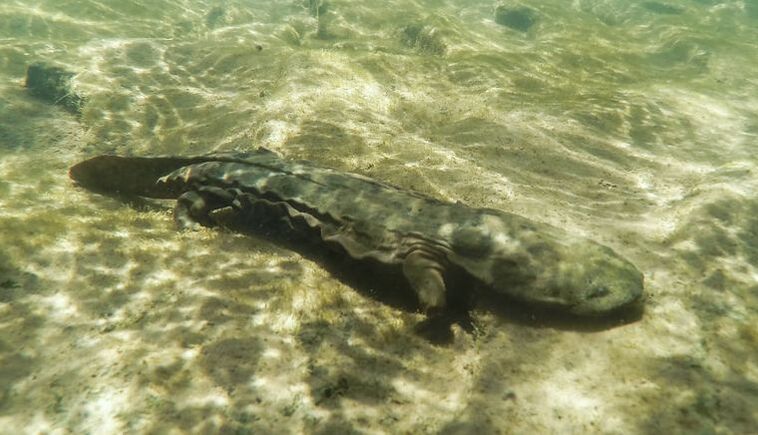|
A lawsuit filed today, Thursday, July 1, 2021, by five conservation groups challenges a decision made in 2019 to deny Endangered Species Act protection to eastern hellbenders. These river-dwelling salamanders can grow longer than two feet and live in clear, fast-flowing mountain streams in 15 southeastern, midwestern and northeastern states. They have now been eliminated from much of their historic range. “Hellbenders, like humans, need clean water to survive. The hellbender’s plight shows that we aren’t doing enough to care for our rivers and streams across the eastern United States,” said Brian Segee, a senior attorney at the Center for Biological Diversity. “We hope this lawsuit will compel the Fish and Wildlife Service to give hellbenders the protections they desperately need to survive.”
Nearly 80 percent of hellbender populations have already been lost or are in decline due to dams and other impoundments, industrial and agricultural water pollution, deforestation, oil and gas development including enhanced recovery techniques such as hydraulic fracturing, residential development, and mining. While acknowledging that those threats will likely intensify, the Service in April 2019 nonetheless found that the hellbender’s protection under the Endangered Species Act is not warranted. “Hellbenders are an important indicator species, invaluable sentinels for clean water as we try to best gauge water quality concerns,” said Middle Susquehanna Riverkeeper John Zaktansky. “Unfortunately, many of the hellbender populations throughout our watershed are drastically declining and need additional protections before it is too late. An endangered or threatened status for this important species would go a long way to securing their future — and the future of the waters on which families throughout our watershed depend.” “Hellbenders need our help now. We must protect their aquatic habitats from erosion, sedimentation and other threats these helpless amphibians continuously face,” said Ted Evgeniadis, the Lower Susquehanna riverkeeper. “It’s been proven through research and scientific data that hellbenders require Endangered Species Act protection. The denial of that protection was arbitrary and our complaint filed today is necessary to defend against further decimation of the greatest indicator species we have for water quality.” “The refusal to federally protect eastern hellbenders was scientifically indefensible and unlawful,” said Daniel E. Estrin, general counsel and advocacy director for Waterkeeper Alliance. “These harmless amphibians are suffering the proverbial death by a thousand cuts as a result of myriad human impacts. We must protect this vital species and its aquatic habitat before it’s too late.” The Service’s decision to deny protection to the hellbender was in large part based on population-augmentation efforts such as the use of artificial nest boxes or release of juvenile hellbenders raised in captivity from wild-caught eggs. While laudable, the ability of these efforts to rebuild populations is unproven, and they do not help to address or diminish the many threats hellbenders face. “The hellbender is an ancient species that deserves better protections,” said Betsy Nicholas, executive director of Waterkeepers Chesapeake. “The hellbender reminds us that we all live downstream. As the upstream tributaries are disturbed and polluted, the hellbender disappears. And that same pollution flows downstream to our populated areas, threatening the use and enjoyment of our rivers. We need to pay attention to what happens to the hellbender.” Today’s lawsuit was filed by the Center, Waterkeeper Alliance, Lower Susquehanna Riverkeeper, Middle Susquehanna Riverkeeper and Waterkeepers Chesapeake. Background The hellbender was once widespread in 15 states but has been eliminated from much of its historic range. This salamander still lives from southern New York to northern Georgia and from the central Appalachians westward to Missouri; remaining populations are concentrated in the Ohio River watershed, the Tennessee and Kanawha River watersheds (both major tributaries to the Ohio River), and the Susquehanna River watershed. There’s also a population in Missouri. Hellbenders are a completely aquatic species, commonly found in cool, highly oxygenated, perennial streams. Boulders, especially large, flat rocks, serve as nest rocks; they provide shelter and cover and are the most important indicator of adult hellbender habitat. Hellbenders breathe through their skin, but also have lungs they can use under some conditions. Hellbenders are primarily nocturnal and move by walking on stream bottoms but can swim short distances to avoid predators. Their lifespan is estimated to be at least 25-30 years and may be closer to 50. Known by colorful names like “devil dog,” “snot otter,” “Allegheny river monster,” “grampus” and “old lasagna sides,” the eastern hellbender’s nicknames reference the loose, frilly skin along its sides and its mucus-like covering, which is believed to provide protection from abrasion and parasites and may have antibiotic properties. The Center petitioned to protect eastern hellbenders under the Endangered Species Act in 2010. The October 2017 “not warranted” finding came after two legal agreements the Center entered into with the Fish and Wildlife Service in 2011 and 2013 to expedite protections.
2 Comments
Gail Landers
7/1/2021 03:34:39 pm
Does not the recent designation of a year ago as the Pa. state reptile (Sen. Gene Yaw) not protect all hellbenders? I remember exploring Lycoming Creek for them in a Lycoming College/King college water course led by professor Mel Zimmerman (2009?)
Reply
Leave a Reply. |
AuthorsRiverkeeper John Zaktansky is an award-winning journalist and avid promoter of the outdoors who loves camping, kayaking, fishing and hunting with the family. Archives
July 2024
Topics |

 RSS Feed
RSS Feed